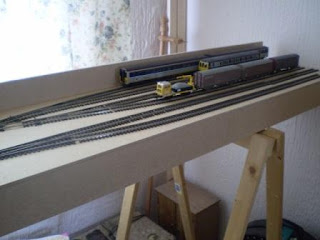There seems to be a reluctance to have a go at the WRG scratch-challenge this year. This surprises me somewhat (or is it the fact that I ducked out last year?)
I've had a couple of ideas: the first is this little beast:

The underlying purpose of the 'rules' was to build something that could run on your existing train set and not be drawn into other places. To this end, following on from the FR 'style' bugboxes that I've recently kitbashed for Garn, I fell upon this - FR No1. This photo from wikipedia, but the original inspiration from Boyd's books and the Spooner Album which lives at Nigel's.
What I don't have is a drawing; despite hunting at Expong on Saturday, just two more or less square-on photos. What this modern rebuild shot shows is the slight bow-ends which are not apparent on the vintage shots. Plus the nasty grills which aren't on the original coach and which I would be happy to omit. Yes I know there is a brass kit available from Worsley Works, but...a PECO wagon chassis and a handful of plasticard.
Not only are drawings of coach No1 scarce, the information surrounding is vague. Boyd, normally very detailed, is quite general:
‘Spooner required... (1864) one first class and two third class... Bodies were 9ft.3in. over sides (and 10ft over bowed ends)long, 6ft. 3in. wide and where roofed(?), 6ft.6 in. from rail... the floor was only 8 in. above the rail...1st class bodies had two windows per side, flanking a central door... single back-to-back seat.’ Boyd F.R. vol 2
This fits the plates 11R and 12R. The earlier in 1887 show the coach open sided, the later from 1932 with the mesh added. But at no point in the text are the corresponding numbers mentioned.
With that information, vague though it is, it should be possible to sketch out a build drawing.
 Started with good intention over a year ago for a competition. The board has an area of three A4 sheets of paper; or put another way: 35" x 8.5". Nearly a year on from the competition date it still sits under the bed... waiting.
Started with good intention over a year ago for a competition. The board has an area of three A4 sheets of paper; or put another way: 35" x 8.5". Nearly a year on from the competition date it still sits under the bed... waiting.



 This does add a certain weight to Roy Link's original idea, but are any of them build-able? Fairford is not a typical station and the plans cram an eighth of a mile of goods yard into 3 feet in 4mm scale. And more importantly if you were to build a GWR branch terminus, are any of them a good place to start?
This does add a certain weight to Roy Link's original idea, but are any of them build-able? Fairford is not a typical station and the plans cram an eighth of a mile of goods yard into 3 feet in 4mm scale. And more importantly if you were to build a GWR branch terminus, are any of them a good place to start?


 And to compare with the original...
And to compare with the original...



















 The underlying purpose of the 'rules' was to build something that could run on your existing train set and not be drawn into other places. To this end, following on from the FR 'style' bugboxes that I've recently kitbashed for Garn, I fell upon this - FR No1. This photo from wikipedia, but the original inspiration from Boyd's books and the Spooner Album which lives at Nigel's.
The underlying purpose of the 'rules' was to build something that could run on your existing train set and not be drawn into other places. To this end, following on from the FR 'style' bugboxes that I've recently kitbashed for Garn, I fell upon this - FR No1. This photo from wikipedia, but the original inspiration from Boyd's books and the Spooner Album which lives at Nigel's.
























